Create, Develop, and Lead Effective Design Teams.
Foreword by Clive Gryner.
Publisher: Springer | Apress.
Pages: 500.
ISBN-10: 1484269535.

“
“Design Management: How to Create, Develop, and Lead Effective Design Teams”, will share insights and frameworks to shape the appropriate capabilities, behavior, and mindset to blend design management and leadership into a symbiotic role that is both inspirational while delivering design excellence. A must-read for designers with an ambition to advance their careers.
Eric Quint
Author of “Design Leadership Ignited”
Former Chief Brand and Design Officer at 3M
Designers are more in-demand than ever, and companies worldwide are creating new leadership roles to manage them. With only a few select institutions teaching effective design management skills, self-taught design managers are on the rise, and resources are needed to guide them. Design Management is here to hone your ability to manage like a leader and magnify your team’s potential.
This book will help designers learn the behavioral abilities required to create, lead and manage high-performing teams using a systemic, context-agnostic, and therefore repeatable approach. While effective design managers are vital in these times of complexity and fast change in organizations, the available literature on design management is insufficient, predominately informative, and, unfortunately, not actionable. This book fills that gap by illuminating the soft and hard skills you need to lead your team to success.
Explore how to manage like a leader leveraging different leadership mindsets to nurture creative collaboration, establish managerial practices to prioritize workload, optimize creative meetings, run successful kickoffs, resolve conflicts productively, nurture healthy relationships, and ultimately achieve results.
Whether you are a designer looking to lead and manage, or a member of an organization looking for guidance on promoting a design-led approach to business, this book is here to assist you in the long haul.
Table of Contents.
PART 01: Manage like a Leader.
01: The Behavioral Elements of a Design Manager.
02: The Building Blocks of a Design Leader.
PART 02: Manage yourself.
03: Create Your Development Program.
04: Establish Your Core Practices.
PART 03: Manage Designers.
05: Build Influence.
06: Create Your Team.
07: Develop Your Team.
PART 04: Manage Design Teams and Workgroups.
08: Nurture Creative Collaboration.
09: Optimize Design Operations.
Other publications.
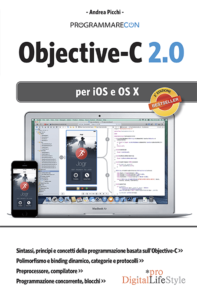
Objective-C 2.0:
FOR IOS AND OSX.
Publisher: LSWR; 2nd edition.
Pages: 850.
ISBN-10: 886604234X.
This book is a comprehensive guide to the Objective-C programming language, the universal language for creating iPhone, iPad, and Mac applications. Through a hands-on approach, you will learn to think like a programmer, use Objective-C to build program logic, and synthesize it into functional applications.
Table of Contents.
PART 01: The Foundations.
01: Objective-C 2.0.
02: Classes, Objects and Methods.
03: Data Types and Expressions.
04: Controlling the Program’s Flow.
PART 02: Advanced Concepts.
05: Inheritance.
06: Categories e Protocols.
07: Preprocessor.
08: Objective-C is also C.
09: Run Time System.
PART 03: Foundation Framework.
10: Introduction to Foundation Framework.
11: Numbers, Strings and Collections.
12: File and Directory.
13: Memory Management.
14: Copying Objects.
15: Archiving Objects.
16: Error Handling.
17: Design Patterns.
PART 04: Concurrent Programming.
18: Blocks.
19: Grand Central Dispatch.
PART 05: Cocoa e Cocoa Touch.
20: Introduction to Cocoa and Cocoa Touch.
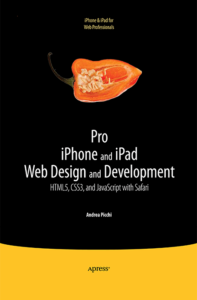
Pro iPhone and iPad Web Design and Development:
HTML5, CSS3, AND JAVASCRIPT WITH SAFARI.
Publisher: Springer | Apress.
Pages: 375.
ISBN-10: 1430232463.
This book is a comprehensive guide to web standards. It will teach you how to use HTML5 to structure websites, CSS3 for styling and appearance, and JavaScript to add program logic to mobile sites and web applications. Through a hands-on approach, you will also learn how to design web-based touch-screen interfaces specifically for Apple’s iOS, taking advantage of its unique features.
Table of Contents.
PART 01: The Foundations.
01. Think Touch Mobile.
02. Design Touch Mobile.
03. Develop Touch Mobile.
PART 02: User Interface Design.
04. User Interface Design for Mobile Touch Devices.
05. iPhone UI Design: Think Simple.
06. iPad UI Design: Think Inverted.
PART 03: Mobile Application Development.
07. Web Standards for WebKit.
08. Creating WebApps.
09. Working in Apple’s Native Mobile Environments.
10. Optimizing WebApps.
11. Testing iPhone and iPad WebApps.
PART 04: Mobile Marketing.
12. Maximizing the Market for WebApps.
13. Looking Beyond the Mobile Web to Ubiquitous Computing.
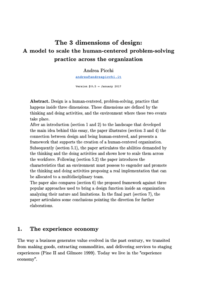
The 3 Dimensions of Design (3DD):
A MODEL TO PROMOTE HUMAN-CENTRED CULTURES.
This white paper presents a new model for addressing the common challenge of fostering a human-centered problem-solving approach within organizations. It explores the essential skills required to be an effective “human-centered problem-solver” and how these abilities can be scaled across an organization. The paper also offers strategic and tactical recommendations designed to facilitate the cultural transformations needed for widespread adoption of these practices, ultimately enabling a more collaborative and empathetic organisational mindset.
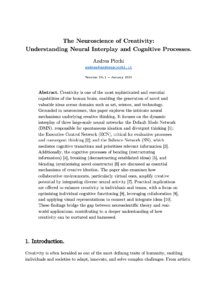
The Neuroscience of Creativity:
UNDERSTANDING NEURAL INTERPLAY AND COGNITIVE PROCESSES.
This white paper explores the neuroscience behind creativity, offering a deep dive into the cognitive processes that drive innovation. By examining key neural networks—such as the Default Mode Network (DMN), Executive Control Network (ECN), and Salience Network (SN)—the paper provides a framework for understanding how the brain generates novel ideas. It also delves into the processes of bending, breaking, and blending information, explaining how these cognitive strategies lead to creative breakthroughs. This manuscript proposes practical applications for enhancing creativity at both the individual and organizational levels, emphasising methods such as mindfulness, collaboration, and exposure to new experiences, all grounded in neuroscience.
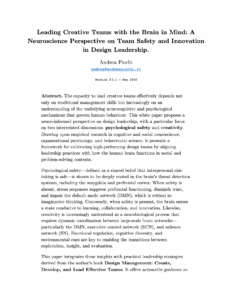
Leading Creative Teams with the Brain in Mind:
A NEUROSCIENCE PERSPECTIVE ON TEAM SAFETY AND INNOVATION IN DESIGN LEADERSHIP
This white paper explores the neuroscience behind psychological safety and creativity in design teams, offering a science-based framework for leadership in high-performing, innovation-driven environments. By examining how key brain systems—such as the limbic system, prefrontal cortex, and large-scale networks like the DMN, ECN, and SN—respond to leadership behaviours and team dynamics, the paper reveals why safety and creativity are neurocognitive conditions, not just cultural ideals. It proposes a practical model for design leaders, structured around environmental conditions, behavioural capabilities, and team rituals that align with how the brain functions under stress, uncertainty, and collaboration. The paper also outlines measurable strategies for fostering inclusion, regulating emotional tone, and sustaining innovation, all grounded in the biology of the creative mind.
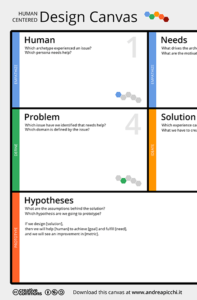
The Human Centered Canvas:
A TOOL TO SUPPORT HUMAN-CENTRED CONVERSATIONS.
The “Human-Centered Canvas” is a strategic tool designed to support the application of the Stanford d.school Design Thinking process within organisations. Drawing inspiration from frameworks such as the Lean UX Canvas and the Business Model Canvas, this model focuses on human-centred problem solving by guiding teams through key phases of ideation and development. The canvas is divided into five quadrants: Empathise (human, needs, goals), Define (problem), Ideate (solution, metrics), Prototype (hypotheses), and Test (validation). It provides a structured yet flexible approach to designing meaningful solutions, enabling teams to focus on human insights, align on objectives, and test ideas effectively to drive innovation and impactful outcomes.

